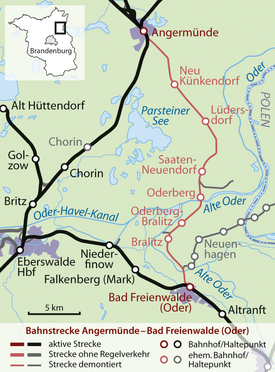Angermünde – Bad Freienwalde railway line
| Angermünde – Bad Freienwalde (Oder) | |||||||||||||||||||||||||||||||||||||||||||||||||||||||||||||||||||||||||||||
|---|---|---|---|---|---|---|---|---|---|---|---|---|---|---|---|---|---|---|---|---|---|---|---|---|---|---|---|---|---|---|---|---|---|---|---|---|---|---|---|---|---|---|---|---|---|---|---|---|---|---|---|---|---|---|---|---|---|---|---|---|---|---|---|---|---|---|---|---|---|---|---|---|---|---|---|---|---|
| Route number (DB) : | 6763 | ||||||||||||||||||||||||||||||||||||||||||||||||||||||||||||||||||||||||||||
| Course book section (DB) : | 296 (1995) 922 (1968) 123a (1944) |
||||||||||||||||||||||||||||||||||||||||||||||||||||||||||||||||||||||||||||
| Route length: | 30.0 km | ||||||||||||||||||||||||||||||||||||||||||||||||||||||||||||||||||||||||||||
| Gauge : | 1435 mm ( standard gauge ) | ||||||||||||||||||||||||||||||||||||||||||||||||||||||||||||||||||||||||||||
| Top speed: | 60 km / h | ||||||||||||||||||||||||||||||||||||||||||||||||||||||||||||||||||||||||||||
|
|||||||||||||||||||||||||||||||||||||||||||||||||||||||||||||||||||||||||||||
The Angermünde – Bad Freienwalde (Oder) line was a single-track, non-electrified branch line in the northeast of Brandenburg . The line was opened in 1877 by the Berlin-Stettiner Eisenbahn-Gesellschaft (BStE). It was laid out as part of a continuous connection from the Upper Silesian coal mining area to the Baltic Sea ports in Szczecin and Swinoujscie , but never got much beyond local importance. The line was operated in passenger and freight traffic until 1995. After its final shutdown on November 30, 1997, it was demolished in 2009.
Route
The 30 kilometer long line began at Angermünde station , where there was a connection to the main line Berlin – Szczecin and the branch lines Angermünde – Stralsund and Angermünde – Schwedt . From there, the railway branched out to the southeast and ran almost in a straight line towards the Oder . Behind the Lüdersdorf train station, the route turned south, passed the Oder-Havel Canal near Oderberg and reached the island of Neuenhagen , which is bounded by the old and new course of the Oder. Shortly before the terminus in Bad Freienwalde , the also disused small train from Hohenwutzen pulled in and the Alte Oder was passed. In Freienwalde the line then merged with the branch line Eberswalde – Frankfurt (Oder) .
history
Angermünde was already accessible from 1842 on the main BStE route between the imperial capital and the provincial capital of Pomerania . Bad Freienwalde followed in 1866 with the construction of a branch line from Eberswalde to Wriezen . The need for another line arose from 1871, when the Breslau-Schweidnitz-Freiburg Railway Company received the concession to build a line from Liegnitz via Küstrin and Königsberg (Neumark) to Stettin, which it built in the following six years. Since the BStE could be "bypassed" in this way, the board of directors of the society pushed ahead with the construction of a parallel stretch to the left of the Oder in 1872. Using the already existing Wriezen – Bad Freienwalde sections and further north Angermünde – Stettin / Ducherow, the Wriezen branch was driven to Frankfurt (Oder) and the Angermünde – Bad Freienwalde railway was created to connect the branch with the main line. Further north, the Ducherow – Swinoujscie route was added, which was designed not only for transporting coal but also for excursions. On January 1, 1877, passenger and goods traffic could be started on the 30 kilometer long line.
In the following years there was a thin regional traffic corresponding to the area, which was limited to the actual route. In 1944, for example, only four pairs of trains ran on the route during the day. Freight traffic, on the other hand, was somewhat more important, as the route ensured a direct connection between Angermünde and the Frankfurt (Oder) node. Nevertheless, there was never a need to double-track the railway.
In the last days of the war in 1945, retreating Wehrmacht members blew up the Oder Bridge near Bad Freienwalde in order to stop the advance of the Red Army . After Germany's unconditional surrender, the entire line was initially dismantled on the orders of the SMAD and brought to the USSR as a reparation payment . However, since the connection represented a significant relief for the Berlin – Angermünde connection, which was reduced to one track, it was rebuilt as a single-track branch line by 1949. The Oder bridge near Bad Freienwalde was not rebuilt, but the route on this section was relocated to the route of the Freienwalde – Zehden small railway, which also had to cross the Oder. Due to the Oder-Neisse Line as a newly established border between the GDR and Poland , the line remained important as a strategic railway , as it was part of a railway connection from Görlitz to Stralsund that was now in the immediate vicinity of the border .
After 1990, however, the end of the railway came because the danger of war was no longer there and, on the other hand, local freight and passenger traffic shifted more towards the road. Freight traffic was discontinued on December 31, 1994 and passenger traffic to the timetable change on May 28, 1995, the official shutdown on November 30, 1997. The attempt to revive the railroad as a trolley line failed.
literature
- Dieter Grusenick, Erich Morlok, Horst Regling: The Berlin-Stettiner Railway . transpress, 1996, ISBN 3-344-71046-X .
- Wolfgang Fiegenbaum, Wolfgang Klee: Farewell to Rails 1991-1995 . transpress, 1997, ISBN 3-613-71057-9 , pp. 62 ff .


